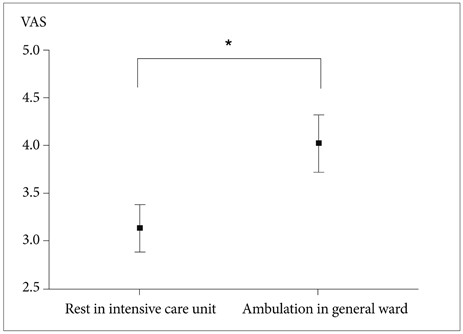Brain Tumor Res Treat.
2013 Apr;1(1):24-27. 10.14791/btrt.2013.1.1.24.
Pain Assessment in Brain Tumor Patients after Elective Craniotomy
- Affiliations
-
- 1Department of Neurosurgery, St. Vincent's Hospital, The Catholic University of Korea, Suwon, Korea. 72ysh@catholic.ac.kr
- KMID: 2165218
- DOI: http://doi.org/10.14791/btrt.2013.1.1.24
Abstract
OBJECTIVE
This study was performed to assess the postoperative pain of brain tumor patients who underwent elective craniotomy and to evaluate the factors associated with pain intensity.
METHODS
From January 2010 to December 2011, 47 patients with newly diagnosed brain tumors who underwent craniotomy were enrolled. The postoperative pain status was assessed daily until discharge using the visual analogue scale (VAS).
RESULTS
The study participants comprised of 22 males and 25 females with ages ranging from 18-76 years (median age, 50 years). Patients were divided into two groups: the painful group included patients who had a VAS score of more than 3 during their hospital stay after the craniotomy, and the tolerable group included patients who had a VAS score of 1 to 3 during their hospital stay. There were no differences between the two groups in terms of age, sex, location of surgery, history of diabetes, hypertension and smoking, body mass index, and hospital stay. Univariate analysis revealed that operating time, length of wound, head fixation, and perioperative administration of opioid were not associated with the intensity of postoperative pain. Daily assessment of VAS revealed the two peaks of pain on the operation day and the 4th postoperative day. The intensity of pain during the ambulation period was higher than that during intensive care unit (ICU) stay.
CONCLUSION
Pain following elective craniotomy for brain tumor removal is insufficiently managed, especially after discharge from the ICU. More attention needs to be paid to patients' pain throughout the hospital stay.
Keyword
MeSH Terms
Figure
Cited by 1 articles
-
The treatment of postcraniotomy pain
Jinhye Min
Anesth Pain Med. 2016;11(4):327-336. doi: 10.17085/apm.2016.11.4.327.
Reference
-
1. Dunbar PJ, Visco E, Lam AM. Craniotomy procedures are associated with less analgesic requirements than other surgical procedures. Anesth Analg. 1999; 88:335–340.
Article2. Kalkman CJ, Visser K, Moen J, Bonsel GJ, Grobbee DE, Moons KG. Preoperative prediction of severe postoperative pain. Pain. 2003; 105:415–423.
Article3. Thomas T, Robinson C, Champion D, McKell M, Pell M. Prediction and assessment of the severity of post-operative pain and of satisfaction with management. Pain. 1998; 75:177–185.
Article4. Morin C, Lund JP, Villarroel T, Clokie CM, Feine JS. Differences between the sexes in post-surgical pain. Pain. 2000; 85:79–85.
Article5. Scott LE, Clum GA, Peoples JB. Preoperative predictors of postoperative pain. Pain. 1983; 15:283–293.
Article6. Rahimi SY, Vender JR, Macomson SD, French A, Smith JR, Alleyne CH Jr. Postoperative pain management after craniotomy: evaluation and cost analysis. Neurosurgery. 2006; 59:852–857. discussion 857.
Article7. Roberts GC. Post-craniotomy analgesia: current practices in British neurosurgical centres--a survey of post-craniotomy analgesic practices. Eur J Anaesthesiol. 2005; 22:328–332.8. Thibault M, Girard F, Moumdjian R, Chouinard P, Boudreault D, Ruel M. Craniotomy site influences postoperative pain following neurosurgical procedures: a retrospective study. Can J Anaesth. 2007; 54:544–548.
Article9. Law-Koune JD, Szekely B, Fermanian C, Peuch C, Liu N, Fischler M. Scalp infiltration with bupivacaine plus epinephrine or plain ropivacaine reduces postoperative pain after supratentorial craniotomy. J Neurosurg Anesthesiol. 2005; 17:139–143.
Article10. Jensen MP, Smith DG, Ehde DM, Robinsin LR. Pain site and the effects of amputation pain: further clarification of the meaning of mild, moderate, and severe pain. Pain. 2001; 91:317–322.
Article11. Klimek M, Ubben JF, Ammann J, Borner U, Klein J, Verbrugge SJ. Pain in neurosurgically treated patients: a prospective observational study. J Neurosurg. 2006; 104:350–359.
Article12. De Benedittis G, Lorenzetti A, Migliore M, Spagnoli D, Tiberio F, Villani RM. Postoperative pain in neurosurgery: a pilot study in brain surgery. Neurosurgery. 1996; 38:466–469. discussion 469-70.
Article13. Quiney N, Cooper R, Stoneham M, Walters F. Pain after craniotomy. A time for reappraisal? Br J Neurosurg. 1996; 10:295–299.
Article14. Gottschalk A, Berkow LC, Stevens RD, et al. Prospective evaluation of pain and analgesic use following major elective intracranial surgery. J Neurosurg. 2007; 106:210–216.
Article15. Hansen MS, Brennum J, Moltke FB, Dahl JB. Pain treatment after craniotomy: where is the (procedure-specific) evidence? A qualitative systematic review. Eur J Anaesthesiol. 2011; 28:821–829.16. Saringcarinkul A, Boonsri . S. Effect of scalp infiltration on postoperative pain relief in elective supratentorial craniotomy with 0.5% bupivacaine with adrenaline 1:400,000. J Med Assoc Thai. 2008; 91:1518–1523.17. Block AR, Ohnmeiss DD, Guyer RD, Rashbaum RF, Hochschuler SH. The use of presurgical psychological screening to predict the outcome of spine surgery. Spine J. 2001; 1:274–282.
Article18. Taenzer AH, Clark C, Curry CS. Gender affects report of pain and function after arthroscopic anterior cruciate ligament reconstruction. Anesthesiology. 2000; 93:670–675.
Article19. Talke PO, Gelb AW. Postcraniotomy pain remains a real headache! Eur J Anaesthesiol. 2005; 22:325–327.
Article20. Stoneham MD, Walters FJ. Post-operative analgesia for craniotomy patients: current attitudes among neuroanaesthetists. Eur J Anaesthesiol. 1995; 12:571–575.21. Verchère E, Grenier B, Mesli A, Siao D, Sesay M, Maurette P. Postoperative pain management after supratentorial craniotomy. J Neurosurg Anesthesiol. 2002; 14:96–101.
Article22. Guignard B, Bossard AE, Coste C, et al. Acute opioid tolerance: intraoperative remifentanil increases postoperative pain and morphine requirement. Anesthesiology. 2000; 93:409–417.
- Full Text Links
- Actions
-
Cited
- CITED
-
- Close
- Share
- Similar articles
-
- Failed First Craniotomy and Tumor Removal of Parasagittal Meningioma with Severe Peritumoral Brain Edema
- Anesthetic considerations for awake craniotomy
- A Case of Microgliomatosis of the Brain
- Development of a contralateral acute subdural hematoma during awake craniotomy for glial tumor in a 12-year-old boy: A case report
- Brain Tumor Mimicking Cervical Spinal Disease: A Case Report



